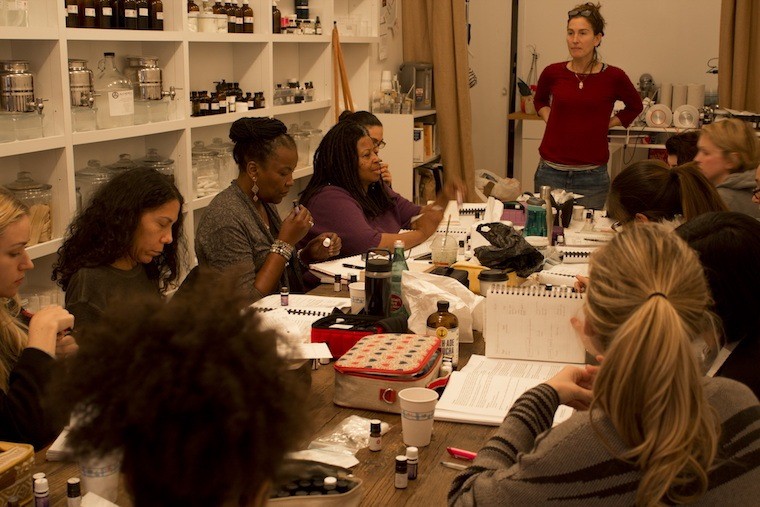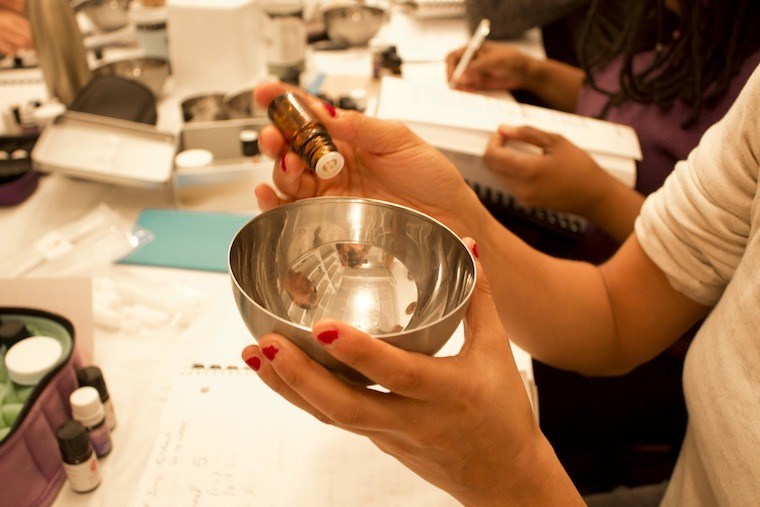Be Your Own Personal Beauty Guru With These Next-Level DIY Skills
You're probably already getting your skin squeaky clean using an oil cleanser. And of course you've gone completely microbead-free. But maybe you want to take things a step further? If you’re one of those people who carefully reads the labels of her natural beauty products and thinks, “I could make this!” I have good news for you: You may be right.
“My number one goal is to inspire people to go home and make their own products,” says Amy Galper, founder of the New York Institute of Aromatherapy. As the trend in beauty veers cleaner and cleaner, it makes sense that some may want to take matters into their own hands, and learn some pro techniques.
“I really think of the Institute as a one-stop shop for DIY beauty,” says Galper (whom you may know her from her natural skin care line Buddha Nose).
At a recent two-hour herbal infusions workshop, taught by Galper, I found myself sitting around a crowded table at the Institute's headquarters in New York City's East Village. To my right was a licensed aesthetician, to my left was an organic beauty entrepreneur, and across from me a visiting nurse from South America looking to learn natural ways to help her cancer patients.

The purpose of our workshop was to learn how (and why) to infuse various medicinal herbs in oils, as the base for many body care products.

{{post.sponsorText}}
Herbal infusions are oils that have been infused, often for several months, with dried medicinal herbs, allowing them to soak up all the beneficial properties of the plants. They’re made with herbs that don’t have a strong scent and therefore don’t have aromatherapeutic properties—not to be confused with aromatherapy oils.
“Think of herbal infusions as highly effective delivery systems for your essential oil blends,” explains Galper. “If you have a massage oil with incredible relaxing aromatherapy oils, why wouldn’t you want to add oil infused with arnica to deliver topical relief as well?”
From echinacea to comfrey, there are all kinds of herbs that you can infuse—and with a variety of benefits. But, you can’t just throw any herbs into any oil and hope for the best. There’s a method—and a whole lot of science—behind the whole thing.
For those who want to make their own herbal infusions, here are the top three tips I picked up:

1. Ingredient quality is key
“The most important thing with herbal infusions is to try to get only certified organic oil and herbs,” says Galper. You can find pretty much everything you need at her shop. But she also likes Starwest Botanicals and Zack Woods Farm if you’re looking to source on your own.
Galper recommends starting out with with the least processed stuff you can find: organic, cold-expressed, virgin, unfiltered olive oil or high oleic acid sunflower seed oil. She likes these because they’re both fairly stable and less expensive than other nut and seed oils.
As for the herbs, they must be properly dried. Never put fresh plant materials in the oil, as the moisture from the leaves and metals will cause mold to form in the infusion.
2. The actual method is remarkably simple
To make the infusion: Fill up a mason jar 3/4 of the way with loose (and dried!) plant material. Don’t pack it down. Then, fill the jar to the very top with your oil of choice, leaving just the tiniest bit of air. Label the jar and put it away somewhere dark and cool for about three months.
When you’re ready to decant, you’ll need a glass or stainless steel bowl, gloves, unbleached cheesecloth, and a strainer. Pour the infused oil over the cheesecloth, into the strainer (perched on top of the bowl). Squeeze until all of the oil is out, put the oil into a labeled jar and you’ve got an herbal infusion.
Note: It’s best if you have a separate set of skin-care equipment from your kitchen tools. You don’t want your echinacea oil to end up with remnants of last night’s dinner in it.
3. Herbal infusions are insanely useful
Here are a few of the best ones to have in your skin-care arsenal:
Echinacea oil: Helpful for inflammation, wound healing, stretch marks, and acne. Galper recommends you use it as part of a natural version of Vick’s Vapo Rub (recipe below), in an anti-aging face serum, or in a salve for cuts and bruises.
Plantain oil (not the same plant as the tropical, banana-like fruit): Good for wound-healing and insect bites. Galper recommends that you use this in a salve for spider bites and other insect bites or in a massage oil blend because of its anti-inflammatory properties.
Yarrow oil: A more astringent anti-inflammatory good for cuts or even acne. If you have excess sebum issues, use this in a face serum to dry it up, Galper says.
Comfrey oil: This one is all about muscle tissue. Use it on swelling, sprains, or tired, achy muscles. It’s highly anti-inflammatory and helps increase circulation, Galper says. This is great in a body oil or cream for massage, but don’t put comfrey on open wounds or cuts (consider yourself warned).
Calendula oil: A very reparative and gentle herb that encourages healthy skin and tissue regeneration. As good on cracked, dry, or damaged skin as it is with sunburns. Consider it the 911 of face or body oils—ideal for any skin that’s in crisis.
The options for DIY skincare products are endless
“Art and science come together in the making of these oils,” explains Galper of the Institute. “I give you the tools and the chemistry, but then you’re really free to use your own creativity and intuition to formulate whatever you need.”
To find a class—everything from Aromatherapy Level 1 training to DIY home cleaning products with essential oils is on offer—check out the Institute's calendar online.
And in case you need a little inspiration (or a little help kicking those end-of-season colds and flus), here’s Galper’s own personal recipe for a blend to rub on your chest to curb congestion:
All-Natural "Vapo Rub"
50 percent sesame oil
12.5 percent comfrey oil
12.5 percent echinacea oil
25 percent calendula oil
Plus a few drops of respiratory oils (like eucalyptus, pine, and frankincense)
Want more DIY inspiration? How about the perfect at-home pedicure in seven steps, a spring detox, or make-your-own pore strips created from leftover coffee, cucumbers, and kombu (really!).
Loading More Posts...